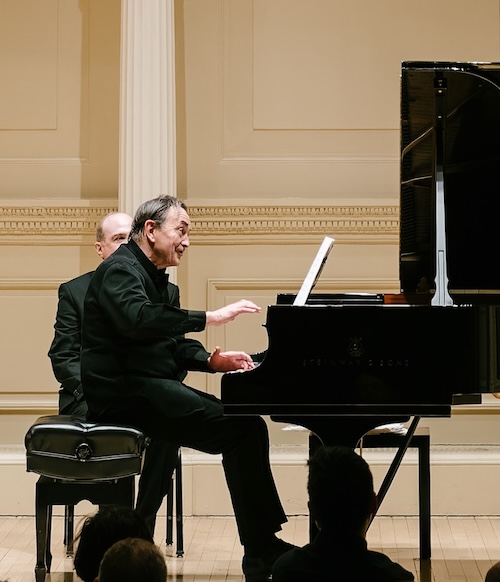Aimard brings clarity, continuity to Boulez and his influences
You can’t throw a rock into the classical music scene without hitting an excellent pianist (and don’t do it, you’ll hurt them) with superlative technique and expressive depth. But there’s still only one Pierre-Laurent Aimard.
The French musician is not only one of the finest keyboard artists of our day, but passionate about the modern and contemporary repertoire. He delivers great performances of challenging works and incorporates them into the classical tradition in a way that shows their stature.
He did this memorably in David Geffen Hall in 2023, honoring György Ligeti’s centennial with the composer’s Etudes mixed together with Beethoven, Chopin, and Debussy. And he did it again Sunday afternoon in Weill Recital Hall, in a concert for Pierre Boulez’ centennial (his birthday is March 26) with another superlative performance.
Aimard alternated Boulez with music from other composers: eight selections from Bartók’s Mikrokosmos, and Gaspard de la nuit by Ravel, set against Boulez’ Piano Sonata No. 1 and Douze notations. On the second, he opened with Schoenberg’s Five Piano Pieces, Op. 23, then two of the four “Formants” (movements) from Boulez’ unfinished, open-structured Piano Sonata No. 3. For an encore he played a piece that felt fully integrated into the program, Anton Webern’s Variations for Piano, Op. 27.
As obvious as it is intellectually and historically, it was invigorating to hear Aimard place Boulez firmly in 20th century modernism, especially because doing so reinforces the fascinating ambiguity in his music. Boulez was always subject to shifting evaluations and perspectives, not least because he himself could be gnomic about his own work. In addition to being highly opinionated about classical music in general, he also changed his values and techniques through his career.
Aimard’s choices covered roughly the first part of the composer’s path, from the student work Douz notations, full of craft and arrogant didacticism, working through Schoenberg’s atonal system in the First Sonata, then exploring aleatory in the Third.
Bartók was a fine introduction, not just a stimulating way to warm up pianist and audience, but via the kaleidoscopic riffs and moods of things like “From the Diary of a Fly,” “Merry Andrew,” and “Staccato,” a presentation of modern piano concepts Boulez built from. The aggressive articulation and willful freedom from standard forms is the essence of Douz notations. Aimard played it with a Shostakovich flavor, forceful from the hands and a poker-faced expression. This is music from a talented but very young artist—the program quotes him as saying “music should be collective hysteria and spells, violently of the present time”—and playing the juxtapositions between the colors of “Lointain” and the bravura passages of “Rapide” made the music more evocative than one expected.
Bravura and evocative are the right words for Gaspard de la nuit, and Aimard’s Ravel playing was potent. He kept the interpretation on the dry side, letting Ravel’s ideas build atmosphere rather than rely much at all on the pedals—and the Steinway in the hall had an out-of-kilter mechanism on one of them that distorted sustained notes in quieter passages and was prevalent in his carefully paced and weighty “Le gibet.” In the outer movements, Aimard’s clear articulation of Ravel’s structures and sense of form was often thrilling to hear, especially the brilliant proportions of drama in “Scarbo.”
The Boulez and Ravel showed Aimard can produce substantial volume, but for him it’s not simple muscularity. There was a conviction about each note, how it should sound, and that was the source of his power, which was just as prevalent in quiet passages.
There was some confusion in the hall as, after playing the first three pieces with only a quick acknowledgment of applause, Aimard went offstage for a short breather before Piano Sonata No. 1, and the house lights came up prematurely.
He returned, explained charmingly that he would continue, then showed tremendous technique in the sonata. It was an interesting choice to separate this from Schoenberg’s Op. 23, because their relationship is close. Aimard captured Boulez’s inherent restlessness, a kind of dissatisfaction with being told how he’s supposed to do things. The sonata is like an argument between Ravel and Schoenberg.
The Five Pieces were marvelous. Aimard phrased the music to show the shape of Schoenberg’s gestures, making both the atonal means and the lyricism in the music clear. The final “Walzer” had a French flavor.
He spoke for a few minute to introduce Sonata No. 3, which even now is still extremely radical music. Boulez’ aleatory was not like that of John Cage—the two had opposing notions of what the idea meant—in that he wrote the music he wanted to hear, but left if up to the performer to choose both the order of the “Formants” and even the direction and structure inside each. Aimard described the music as asking the question, “How can we get rid of its decided form?”
For that, he played No. 3, “Constellations—Miroir,” then No. 2, “Trope,” and played parts of No. 3 both forward and backward. This was remarkable to hear. This is music that lies beyond clear understanding and even familiarity, but Aimard’s shaping of phrase and his deliberate way in the silent spaces within was like watching the reflections of sun and clouds on shifting water—a set of events that the listener could assemble in their own way. Ironically, he’s such a fine musician that he played something that’s full of chance with a sense of continuity that no one else likely could find.
The densest music sings under this pianist’s hands. With that and the Webern encore, played with as much focus as the rest of the program, Aimard placed another profound look at music history in front of the listener.
Pierre-Laurent Aimard plays Sweelinck, Carter, Chopin, Mozart, C.P.E. Bach, Beethoven, and Ives, 3 p.m. Sunday, May 5. carnegiehall.org
